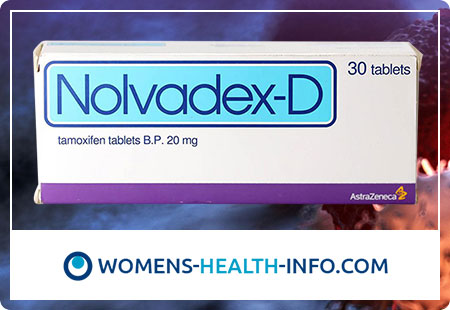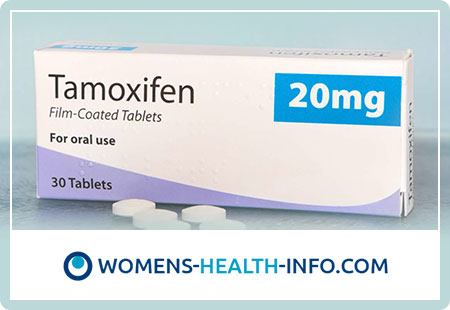
Nolvadex (Tamoxifen)
In the world, Nolvadex is recognized as the safest and most effective drug that affects estrogen receptors.
The drug is used for the prevention and treatment of malignant breast tumors, Albright's syndrome. As an antiestrogen, Nolvadex helps to cure these diseases.
Instructions for use
Before starting a therapeutic course using Nolvadex tablets, you must read the instructions for use. It contains important information about the peculiarities of taking the medicine, interactions with other medicines, and possible adverse reactions. Failure to comply with the recommendations prescribed in the instructions may lead to the ineffectiveness of the drug taken.
Dosage form and active ingredient
Nolvadex is available in film-coated tablets. The package contains 100 pieces of 20 mg each.
The main active ingredient is tamoxifen (TMX).
Pharmacological group
Nolvadex belongs to anticancer drugs and acts as a hormone antagonist (antiestrogen).
Pharmacodynamics
The active ingredient is similar to estrogen and tends to bind to receptors in target organs. Tamoxifen enters the tumor nucleus, stops the action of female steroid hormone and thereby inhibits the development of malignant tumors. After a single use for another 2 - 3 weeks, it is able to maintain the function of blocking estrogen.
Pharmacokinetics
The pharmaceutical agent is well absorbed in the gastrointestinal tract. The absorption period ranges from 4-7 hours. 99% of the active substance binds to plasma proteins. Nolvadex is metabolized in the liver (hydroxylation and demethylation reactions), excreted mainly in the bile. Excretion is divided into two phases: T1 and T2. The first ends within 13 hours after admission, the second in a week. A small part of the drug is excreted in the urine.
Information on the main active ingredient
The main component of the antiestrogen is tamoxifen. It is a white powder, slightly soluble in water. Diluted with organic solvents. The substance acts on the body and is metabolized in the liver using the cytochrome P450 isoforms CYP2D6 and CYP3A4 into active metabolites.
Indications for use:
Nolvadex is effective against the following diseases:
- breast cancer (BC), kidney, endometrial cancer
- oligospermia
- albright's syndrome
Contraindications
![blockquote]() Before prescribing Nolvadex, the doctor excludes pregnancy, because the tablets can affect the development of the embryo. It is not recommended to take antiestrogen while breastfeeding.
Before prescribing Nolvadex, the doctor excludes pregnancy, because the tablets can affect the development of the embryo. It is not recommended to take antiestrogen while breastfeeding.
Contraindications to the appointment of anticancer pills are also:
- individual intolerance to the active substance
- development of cataracts
- thrombophlebitis
- leukopenia and thrombocytopenia
Today, the drug is undergoing clinical trials as a treatment for other forms of cancer and estrogen-dependent diseases.
Application and doses
The dosage depends on the type of disease. In case of breast, endometrial, and renal cancer, 20-40 mg is administered orally twice a day (morning and evening), and the administration continues until positive dynamics appear. The course is 2.4 - 9.6 g.
If a woman does not become pregnant due to anovulation: on the second day after the onset of menstruation, 10 mg of the medicine should be taken 2 times a day for 4 days. Under the supervision of a physician, the dose can be increased to 20 or even 40 mg.
With a decrease in sperm production during ejaculation, the therapeutic dose is 10 mg per day.
The peculiarity of the reception is that the pill must be taken without chewing with a small amount of still water.
The drug is prescribed strictly under the supervision of an oncologist or mammologist.
Carefully
For children, the dosage is 20 mg once a day. This dose has been clinically tested in 28 girls. In the course of therapy, an increase in the uterus was recorded. More research has not been done on children.

Side effects
Nolvadex is a fairly strong drug, so after taking it, a number of side effects may appear:
- increased risk of thrombophlebitis;
- increased performance of liver enzymes;
- stroke;
- pulmonary embolism;
- vision problems;
- weight loss;
- nausea, vomiting;
- headache;
- intermenstrual bleeding;
- confusion of consciousness;
- depressive disorders;
- violation of the functional work of the liver (with a long course);
- osteoporosis;
- obstructive jaundice (due to the formation of stones in the gallbladder with prolonged therapy);
- decrease in the number of active sperm;
- malignant neoplasm developing from the epithelium of the uterus (single case).
Compared to other antiestrogens, Nolvadex has minor complications, most of which do not manifest under medical supervision.
Interaction with other medicinal products
Cytostatic drugs increase the risk of blood clots. Colchicine affects the hepatotoxicity of tamoxifen. Ftorafur can cause hepatitis and liver cirrhosis. The combination of tamoxifen and hormonal medicines leads to the accumulation of calcium ions in the body, which can cause hypercalcemia. Pharmaceutical products intended for the treatment of acid-dependent diseases of the gastrointestinal tract can dissolve the tablet shell and inhibit its effect.
Alcohol compatibility
It is strictly forbidden to take alcoholic beverages in case of serious diseases associated with the cardiovascular and other systems. In men, due to the increased production of testosterone, the liver works more actively. It is influenced not only by the sex hormone, but also by the drug itself.
Alcohol can become a causal aggravation of the pathological process, the appearance of new side effects that should not be observed after taking antiestrogen tablets.
Special instructions
Patients who are taking anticancer medication should be closely monitored by a gynecologist. If bleeding develops, it should be discontinued. The same situation is with the appearance of blood clots in the vessels of the lower extremities.
Overdose
It is manifested by an increase in side effects. Therapy is prescribed based on the symptoms of intoxication.
Storage conditions
The active substance is hygroscopic and hypersensitive to ultraviolet light. Therefore, it is recommended to store Nolvadex in a place protected from light, at a temperature not higher than 30 ° C, away from moisture.
Shelf life
Observing all the conditions written in the instructions, the drug can be stored for 60 months.
Termination of therapy
Cancellation of taking the medication is possible only after completing the course prescribed by the doctor.

Tamoxifen
Pharmachologic effect
Antineoplastic agent. Tamoxifen has a combined spectrum of pharmacological action - both an estrogen antagonist and an estrogen agonist in various tissues. In patients with breast cancer in tumor cells, tamoxifen is mainly antiestrogenic, preventing the binding of estrogens to estrogen receptors. Tamoxifen, as well as some of its metabolites, compete with estradiol for binding sites with cytoplasmic estrogen receptors in the tissues of the breast, uterus, vagina, anterior pituitary gland, and tumors with a high estrogen content. In contrast to the estrogen receptor complex, the tamoxifen receptor complex does not stimulate DNA synthesis in the nucleus, but inhibits cell division, which leads to regression of tumor cells and their death.
Pharmacokinetics
After oral administration, tamoxifen is well absorbed from the gastrointestinal tract. Cmax in serum is achieved within 4 to 7 hours after taking a single dose. Serum Css is usually reached after 3-4 weeks. Plasma protein binding - 99%. It is metabolized in the liver to form several metabolites. The elimination of tamoxifen from the body is biphasic with an initial T1 / 2 from 7 to 14 hours and followed by a slow terminal T1 / 2 for 7 days. It is excreted mainly in the form of conjugates, mainly with feces; in small quantities excreted in the urine.
Indications of active substances of the drug Tamoxifen
Breast cancer in menopausal women, breast cancer in men after castration, kidney cancer, melanoma (containing estrogen receptors), ovarian cancer; prostate cancer with resistance to other drugs.
Dosage regimen
The method of application and dosage regimen of a particular drug depends on its form of release and other factors. The optimal dosage regimen is determined by the doctor. The compliance of the used dosage form of a particular drug with indications for use and dosage regimen should be strictly observed.
The dosage regimen is set individually, depending on the indications, the patient's condition and the applied anticancer therapy regimen.
Side effect
- From the immune system: hypersensitivity reactions.
- From the hematopoietic system: often - anemia; infrequently - leukopenia, thrombocytopenia; rarely - arganulocytosis, neutropenia; very rarely - pancytopenia.
- From the endocrine system: often - hypercalcemia (especially in patients with bone metastases at the beginning of therapy).
- From the side of metabolism: very often - fluid retention in the body; often - an increase in the concentration of triglycerides in plasma; very rarely - a significant increase in the plasma concentration of triglycerides, sometimes in combination with pancreatitis; frequency unknown - weight gain, anorexia.
- From the nervous system: often - headache, dizziness; frequency unknown - depression, confusion, photophobia, drowsiness.
- From the side of the organ of vision: often - visual impairment (sometimes reversible, including cataracts, retinopathy, corneal changes); rarely - neuropathy of the optic nerve, optic neuritis (including with the development of blindness).
- From the side of the cardiovascular system: often: leg cramps, transient ischemic attacks, thromboembolism, incl. thromboembolism of the pulmonary arteries (the risk of thromboembolic complications increases with combination therapy with other cytotoxic drugs), deep vein thrombosis of the lower extremities; infrequently - stroke.
- From the respiratory system: infrequently - interstitial pneumonitis.
- From the digestive system: very often - nausea; often - vomiting, diarrhea, constipation.
- From the liver and biliary tract: often - an increase in the activity of hepatic transaminases, fatty degeneration of the liver; infrequently - cirrhosis of the liver; very rarely - cholestasis, hepatitis, jaundice, liver cell necrosis, liver failure (including fatal).
- Skin and subcutaneous tissue disorders:very often - rash; often - urticaria, alopecia, hypersensitivity reactions (including angioedema); rarely - vasculitis; very rarely - systemic lupus erythematosus, erythema multiforme, Stevens-Johnson syndrome, bullous pemphigoid.
- Musculoskeletal and connective tissue disorders:often - myalgia; very rarely - ossalgia.
- On the part of the reproductive system:very often - vaginal bleeding, vaginal discharge, menstrual irregularities (including amenorrhea in women in the premenopausal period); often - itching in the genital area, an increase in uterine fibroids, proliferative changes in the endometrium (neoplasia, hyperplasia, polyps, rarely endometriosis); infrequently - endometrial cancer; rarely - polycystic ovary disease, uterine sarcoma (often malignant mixed tumor of Muller), vaginal polyposis, decreased libido in men, impotence in men.
- Others:very often - hot flashes (due to the antiestrogenic effect of tamoxifen); rarely - pain in the area of the affected tissues (especially at the beginning of therapy); very rarely - late cutaneous porphyria; the frequency is unknown - an increase in body temperature, increased fatigue. At the beginning of treatment, a local exacerbation of the disease is possible - an increase in the size of soft tissue formations, sometimes accompanied by severe erythema of the affected areas and adjacent areas (usually disappears within 2 weeks).
Contraindications for use
Hypersensitivity to tamoxifen; pregnancy, lactation (breastfeeding); children's age - depending on the dosage form.
With care: renal failure, diabetes mellitus, eye diseases (including cataracts), deep vein thrombosis and thromboembolic disease (including history), hyperlipidemia, leukopenia, thrombocytopenia, hypercalcemia, concomitant therapy with indirect anticoagulants.
Application during pregnancy and lactation
Contraindicated for use during pregnancy and lactation (breastfeeding). If necessary, use during lactation should stop breastfeeding.
There are reports of spontaneous abortion, congenital malformations and fetal death in women taking tamoxifen during pregnancy, although a causal relationship has not been established.
Tamoxifen inhibits lactation.
Application for impaired renal function
Use with caution in case of renal failure.
Application in children
It can be used in children according to indications, in recommended doses and dosage forms. It is necessary to strictly follow the instructions in the instructions for tamoxifen preparations on contraindications for the use of specific dosage forms of tamoxifen in children of different ages.
Special instructions
During the period of therapy, it is necessary to periodically monitor the blood coagulation indicators, the calcium content in the blood, the blood picture (leukocytes, platelets), liver function indicators, blood pressure, and conduct an examination with an ophthalmologist.
Women receiving tamoxifen therapy should have regular gynecological examinations.
In patients with hyperlipidemia, during treatment, it is necessary to control the concentration of cholesterol and triglycerides in the blood serum.
Tamoxifen should not be used in combination with drugs containing hormones, especially estrogens.
When used simultaneously with drugs that affect the blood coagulation system, a dose adjustment of tamoxifen is necessary.
Influence on the ability to drive vehicles and mechanisms
During the period of tamoxifen use, patients should be careful when driving vehicles and mechanisms, as well as when engaging in other potentially hazardous activities that require increased concentration of attention and speed of psychomotor reactions.
Drug interactions
With simultaneous use with anticoagulants with coumarin derivatives, the risk of increased anticoagulant action increases; with cytostatics - an increase in the risk of thrombus formation is possible.
With simultaneous use with allopurinol, hepatotoxic effect is possible; with aminoglutethimide - a decrease in the concentration of tamoxifen in plasma, apparently due to an increase in its metabolism.
Patients receiving tamoxifen may experience prolonged neuromuscular blockade caused by atracurium.
With the simultaneous use of bromocriptine, it is possible to enhance the dopaminergic action of bromocriptine.
In patients receiving tamoxifen, when using warfarin, there is a risk of developing a threatening clinical situation: prolongation of prothrombin time, hematuria, hematoma is possible.
With simultaneous use with mitomycin, the risk of developing hemolytic uremic syndrome increases.
Estrogens can reduce the therapeutic effect of tamoxifen.
Drugs that reduce calcium excretion (such as thiazide diuretics) may increase the risk of hypercalcemia.
The combined use of tamoxifen and tegafur may contribute to the development of active chronic hepatitis and liver cirrhosis.
The simultaneous use of tamoxifen with other hormonal drugs (especially, estrogen-containing contraceptives) leads to a weakening of the specific effect of both drugs.
It is possible to reduce the plasma concentration and clinical effect of tamoxifen when used simultaneously with potent inhibitors of the isoenzyme CYP2D6 (for example, paroxetine, fluoxetine, quinidine, cinacalcet, bupropion, antidepressants from the group of selective serotonin reuptake inhibitors).
Tamoxifen should not be used concomitantly with anastrazole, since it can weaken the pharmacological effect of the latter.
 DE
DE FR
FR IT
IT ES
ES





